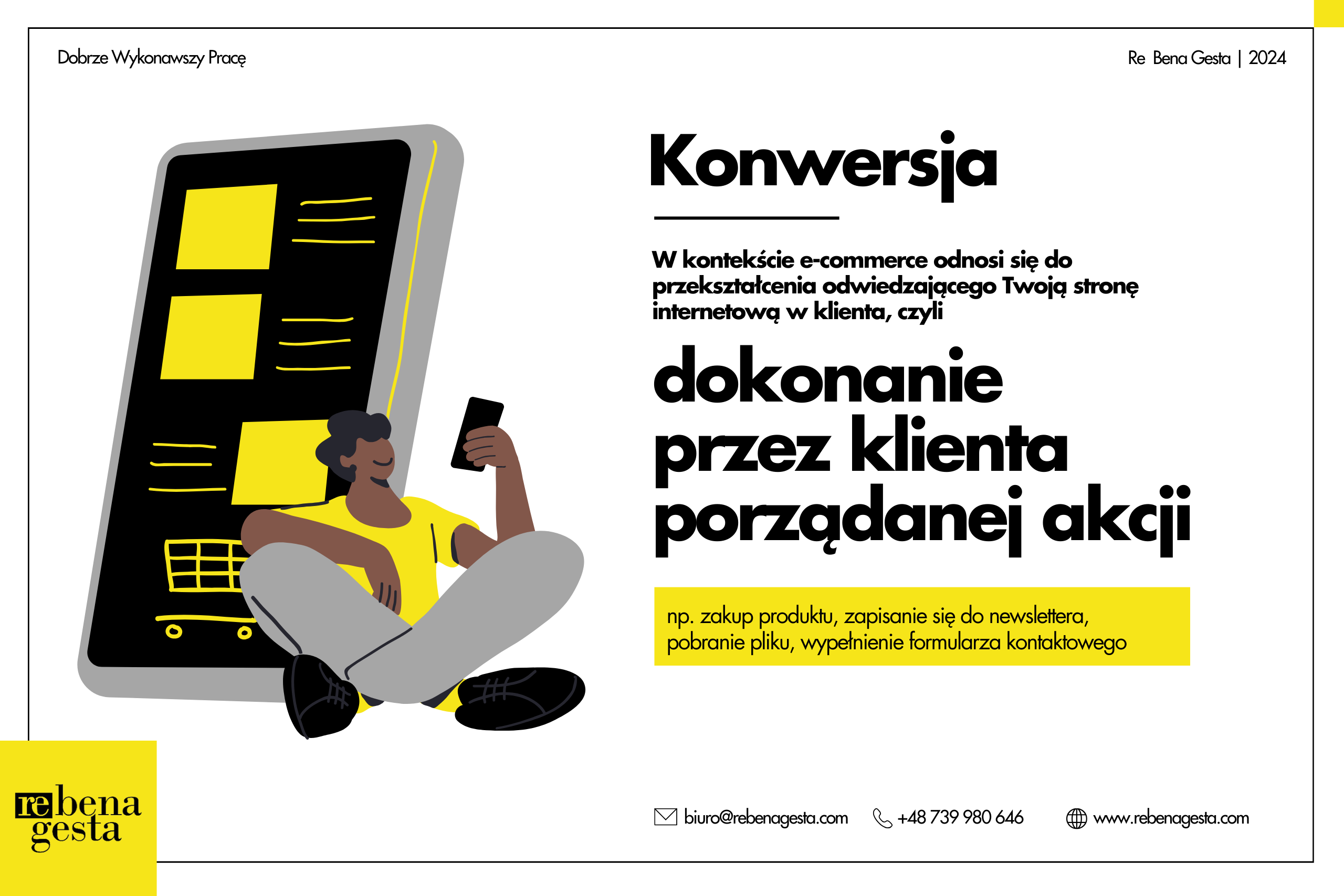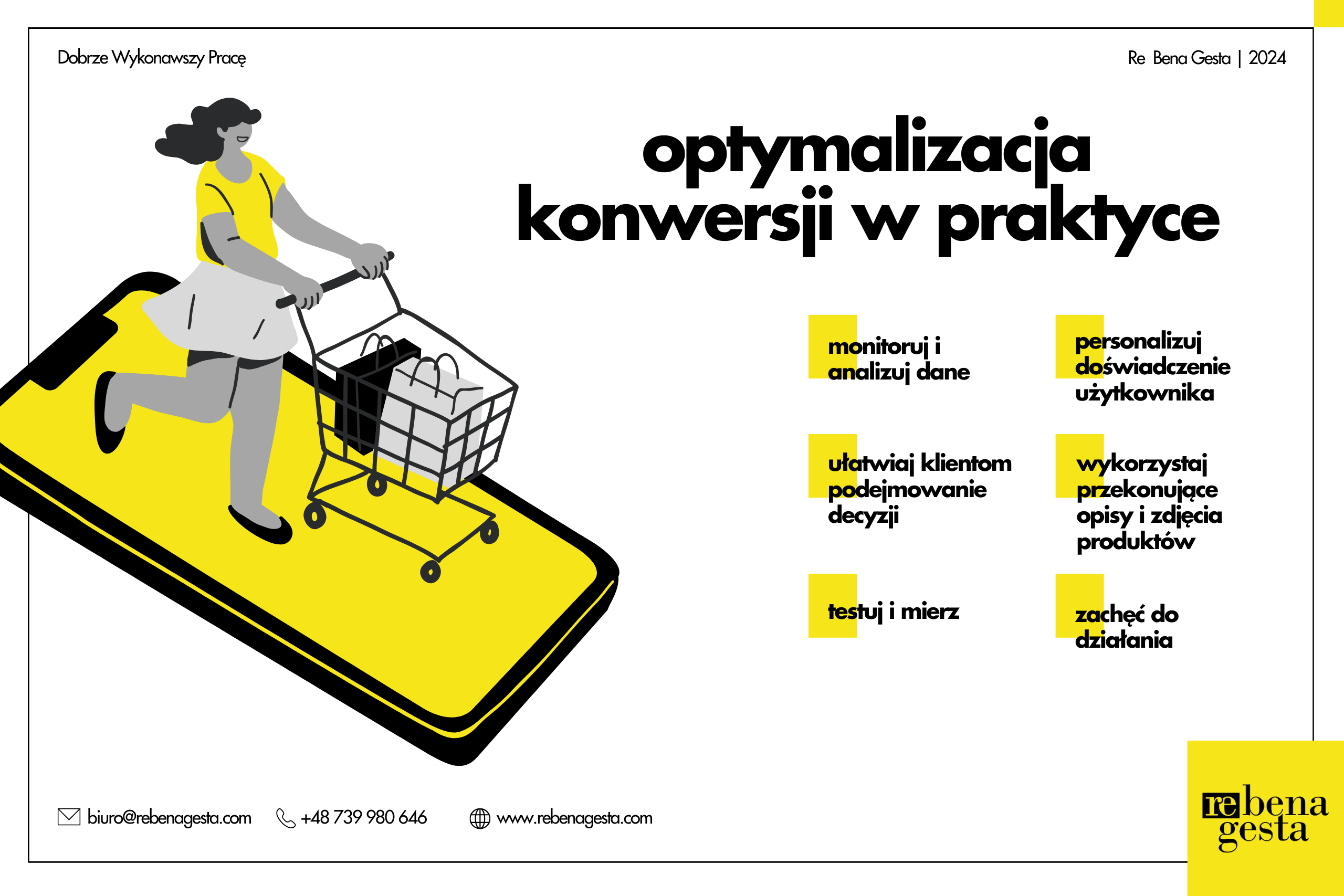Conversion – the most important indicator in eCommerce
Conversion – what is it?
Conversion – this word is the key to success in the e-commerce industry. Whether you’re running an online store for clothing, electronics or services, conversion efficiency is of paramount importance to the success and growth of your online business. But what really is conversion and why is it so important? In this article, we’ll take a closer look at the issue and discover how you can optimize the conversion process in your online store.
What does it mean in practice?
Conversion, in the context of e-commerce, refers to the conversion of a visitor to your website into a customer, that is, the visitor completes a desired action. This desired action could include buying a product, signing up for a newsletter, downloading a file, filling out a contact form, or taking some other desired action.
Adam is the owner of a well-known coffee roaster in Silesia. At the beginning of his business, he started offering his services and products stationary in one of his coffee shops in Bielsko-Biala. Over time, he set up his own online platform, offering unique and high-quality espresso machines, coffee makers and coffees from many corners of the world. His commitment to the company’s growth was great, but after some time he began to notice that his website was not generating the expected number of customers and thus sales.Adam realized that his website needed a thorough optimization.He noticed that competition in the e-commerce industry was getting tougher, and that his platform needed to stand out, both in search engines and in the eyes of customers. He was ready to take action that would bring the desired results, so he decided to seek professional help.
Why is conversion so important for eCommerce companies?
The answer is simple – conversion is directly related to a company’s revenue. The higher the conversion, the higher the revenue. High conversion means that a company is convincing its visitors to buy products or take advantage of an offer. This is a key success indicator for any eCommerce company, as it converts potential customers into loyal and returning customers.
Factors affecting conversion
Conversion optimization is a process that requires consideration of many factors. Here are some of the key factors that can affect conversion on your eCommerce store. 1. Website design: The first impression is key. Your website design should be attractive, professional and easy to navigate. An intuitive and easy to navigate site makes it easy for visitors to find the information or products they need. Any obstacles, such as an overly complicated shopping cart or unstable features, can discourage visitors and lead to low conversions 2. Responsiveness of the site: It’s worth making sure your site is responsive so that it can be accessed on different devices, such as smartphones and tablets. If the site is not responsive to all used resolutions then there is a high probability that it will display poorly on some devices and the potential customer will leave the site without performing the desired action. 3. Content and product descriptions: The quality of content and product descriptions is of paramount importance in convincing customers to make a purchase. Carefully crafted, attractive and detailed product descriptions can increase customer confidence and encourage customers to make a purchase. 4. Price and promotions: The price of products and available promotions have a direct impact on a customer’s purchase decision. Presenting attractive prices and bargains can increase conversions and encourage customers to return to your store. 5. Payment process: The payment process should be quick, simple and hassle-free. Long forms, lack of available payment options, or lack of trusted payment systems can discourage customers and lead to shopping cart abandonment. 6. Customer reviews: Positive customer reviews can significantly influence other customers’ buying decisions. Try to collect reviews from satisfied customers and share them on your website. Positive reviews and testimonials can build trust and convince others to buy.
1. Website design: The first impression is key. Your website design should be attractive, professional and easy to navigate. An intuitive and easy to navigate site makes it easy for visitors to find the information or products they need. Any obstacles, such as an overly complicated shopping cart or unstable features, can discourage visitors and lead to low conversions 2. Responsiveness of the site: It’s worth making sure your site is responsive so that it can be accessed on different devices, such as smartphones and tablets. If the site is not responsive to all used resolutions then there is a high probability that it will display poorly on some devices and the potential customer will leave the site without performing the desired action. 3. Content and product descriptions: The quality of content and product descriptions is of paramount importance in convincing customers to make a purchase. Carefully crafted, attractive and detailed product descriptions can increase customer confidence and encourage customers to make a purchase. 4. Price and promotions: The price of products and available promotions have a direct impact on a customer’s purchase decision. Presenting attractive prices and bargains can increase conversions and encourage customers to return to your store. 5. Payment process: The payment process should be quick, simple and hassle-free. Long forms, lack of available payment options, or lack of trusted payment systems can discourage customers and lead to shopping cart abandonment. 6. Customer reviews: Positive customer reviews can significantly influence other customers’ buying decisions. Try to collect reviews from satisfied customers and share them on your website. Positive reviews and testimonials can build trust and convince others to buy.
While searching for a solution to his e-commerce site optimization problems, Adam came across Re Ben Gest. Our first meeting with Adam was the moment we understood his business needs and goals. We conducted a detailed analysis of his website, identifying areas for improvement. What Adam didn’t realize was that errors on the site such as 404 errors, images that were too large, loading times of 9 seconds, as many as 40 plugins or little content were not encouraging a potential customer to buy.
Key metrics for measuring eCommerce conversions
There are many metrics that can be used to measure eCommerce conversions. One of the most popular metrics is the conversion rate, which measures the number of transactions made relative to the number of website visits. Another important indicator is the average order value, which shows the average value of a purchase made by a customer. In addition, it is worth monitoring the rejection rate, which measures the percentage of visitors who leave the site without performing any action. All these metrics are crucial for monitoring and evaluating the effectiveness of an eCommerce conversion strategy.
Through the SEO and UX audit, we proposed a comprehensive action plan, as well as a strategy for long-term optimization.
Our treatments in the first quarter of 2020 resulted in a 300% increase in sales! During this time, we worked on, among other things, rebuilding the store and improving UX, creating new categories and unique content, inaugurating the , “blog” tab, and expanding the contact sub-page to achieve higher results in Google business cards. Already in the first month, revenue increased from PLN 11,000 to PLN 33,000 after the launch of the new online store.
Conversion optimization in practice
Conversion optimization is a process of continuous learning and improvement. Here are some practical tips that can help you optimize the conversion process in your online store. 1. Monitor and analyze data: Use analytics tools such as Google Analytics to track and analyze data on site traffic, user behavior and conversion rates. Use this data to identify areas for improvement and take appropriate action. 2. Test and measure: Use A/B testing and other testing methods to test different variations of site design, content, shopping cart layout and other elements to identify the best solutions to increase conversions. 3. Make it easy for customers to make decisions: Provide sufficient product information, offer buying guides, product comparisons and other tools to help customers make an informed choice 4. Personalize the user experience: Use customer data such as preferences, purchase history and site navigation to deliver a personalized user experience. Offer product recommendations and customized offers that will grab customers’ attention and increase the chances of conversion. 5. Use compelling product descriptions and images: Well-edited descriptions and high-quality photos can grab customers’ attention and convince them to buy. Try to use graphics of the best rank, correctly framed and well lit. The text should contain all relevant information that will not leave the viewer with a key question about the product. 6. Encourage action: It is important to place clear and effective CTA (Call-to-Action) buttons that will prompt users to perform the desired action. Test that they are visible and legible. It is important that the CTA buttons are always in sight of visitors so that they can easily take the desired action.
1. Monitor and analyze data: Use analytics tools such as Google Analytics to track and analyze data on site traffic, user behavior and conversion rates. Use this data to identify areas for improvement and take appropriate action. 2. Test and measure: Use A/B testing and other testing methods to test different variations of site design, content, shopping cart layout and other elements to identify the best solutions to increase conversions. 3. Make it easy for customers to make decisions: Provide sufficient product information, offer buying guides, product comparisons and other tools to help customers make an informed choice 4. Personalize the user experience: Use customer data such as preferences, purchase history and site navigation to deliver a personalized user experience. Offer product recommendations and customized offers that will grab customers’ attention and increase the chances of conversion. 5. Use compelling product descriptions and images: Well-edited descriptions and high-quality photos can grab customers’ attention and convince them to buy. Try to use graphics of the best rank, correctly framed and well lit. The text should contain all relevant information that will not leave the viewer with a key question about the product. 6. Encourage action: It is important to place clear and effective CTA (Call-to-Action) buttons that will prompt users to perform the desired action. Test that they are visible and legible. It is important that the CTA buttons are always in sight of visitors so that they can easily take the desired action.
With the initial achievement, Adam decided to work with us further. We created a new series for the blog , “product on the go,” posted on forums and thematic blogs, developed sponsored articles and a social media brand strategy.
Adam noticed that after the changes, there was a significant increase in traffic to the site (290% increase in organic traffic), and consequently an increase in customers and sales. His platform began to rank higher in search results (515% increase in the number of keyword visibility in Google), and users showed more engagement when browsing and shopping.
His company gained new opportunities for growth, and he was able to focus on further developing his assortment and building relationships with customers, knowing that his online store was operating effectively and producing the desired results.
You can read more about this case study here.
Summary
Conversion plays a key role in the e-commerce industry. Optimizing the conversion process can lead to increased sales, increased customer loyalty and the success of your online business. Ensure an attractive website design, quality content, competitive pricing, easy payment process and positive customer feedback. Monitor and analyze data, test different variations and personalize the user experience. Remember, conversion optimization is an ongoing process that requires attention and commitment, but can yield significant results for your e-commerce business.
Adam’s story is one of many success stories from our clients who have chosen to use our SEO and UX auditing services. In 2021, the average increase in sales was maintained at +260% over the original.
Thanks to our help, many entrepreneurs have succeeded in the dynamic world of e-commerce, which is our greatest reward for our commitment.
E-commerce website optimization is not only our job – it’s also a passion and a mission, which motivates us to constantly improve and help clients achieve their business goals. Or maybe you have faced similar problems to Adam’s in your business and need our help? Contact us now! Thisarticle is based onKARWATKA, Tomasz; SADULSKI, Dawid. E-commerce: simple answers to difficult questions. Wolters Kluwer, 2011;KOPEĆ, Agata. Design of modification of the conversion path in the online store from the clothing industry. 2019 PhD Thesis. Department of Management Processes.GĄSIORKIEWICZ, Artur. Traffic shaping factors (web-traffic) and their impact on the level of conversion in the websites of e-commerce systems in the B2C segment. Zeszyty Naukowe Uniwersytetu Szczecińskiego. Ekonomiczne Problemy Usług, 2010, 57 E-economy in Poland. Current state and prospects for development. Part I: 637-645.ĆWIERTNIAK, Ryszard; WIKOWSKA, Karolina. SEO optimization in e-commerce: key factors and their role in effective content marketing. Zeszyty Naukowe Wyższej Szkoły Ekonomii i Informatyki w Krakowie, 2023, 19: 13-44.PAŁCZYŃSKA, Michalina, et al. The impact of social media promotion on stimulating online store purchases. Zeszyty Naukowe Wyższej Szkoły Ekonomii i Informatyki w Krakowie, 2023, 19: 211-230.ŚPIEWAK, Rafał. The use of UX audit elements and Google tools to evaluate online store websites. Zeszyty Studenkie “Nasze Studia”, 2023, 13: 241-249.